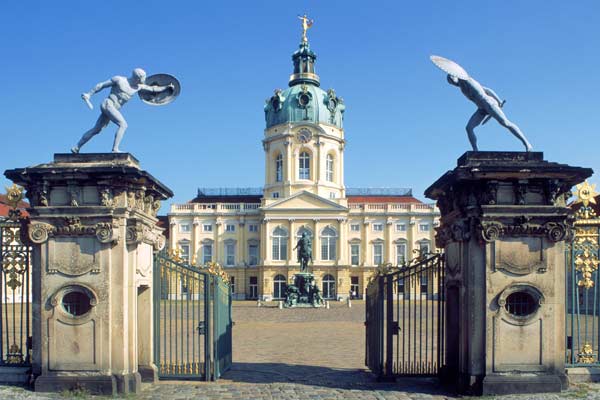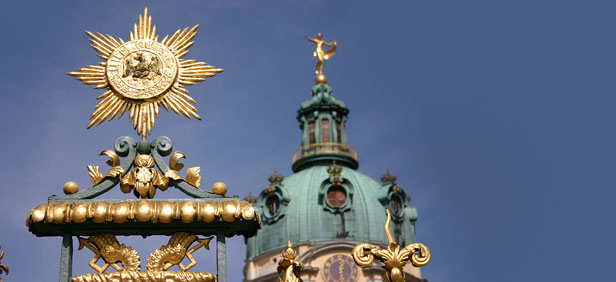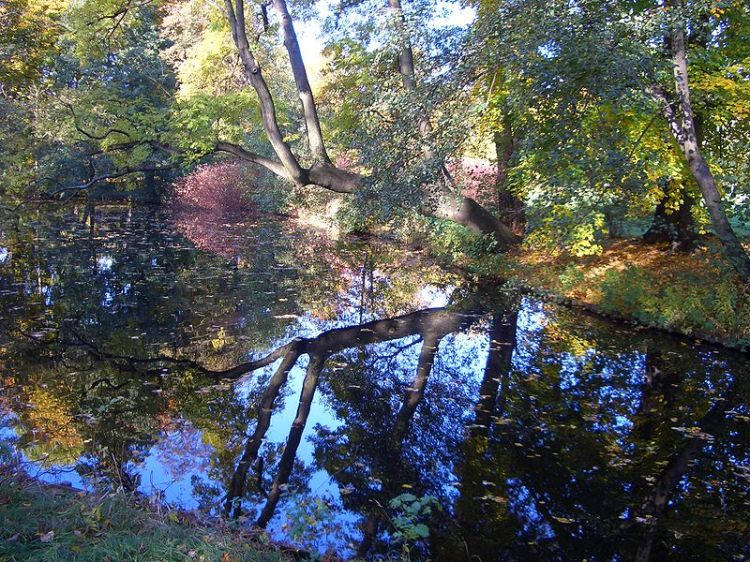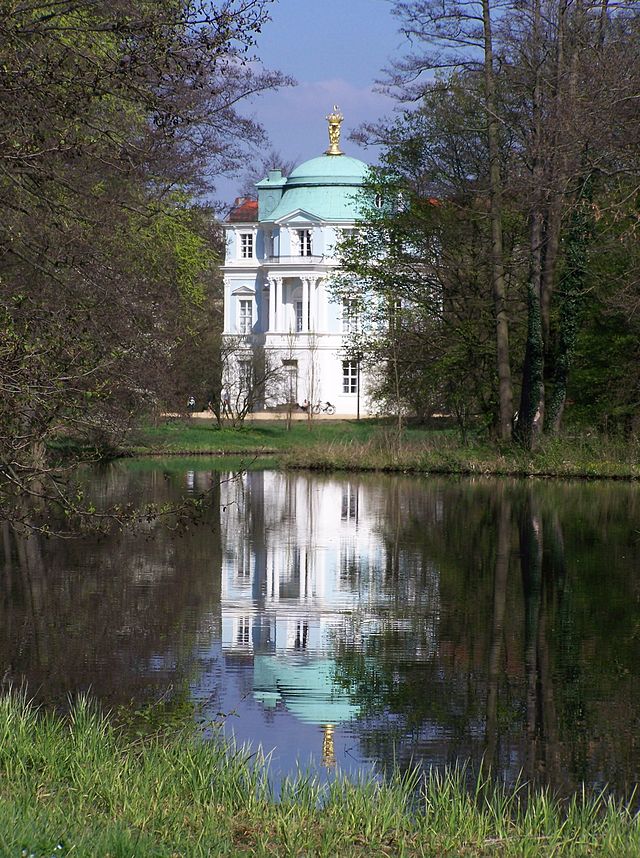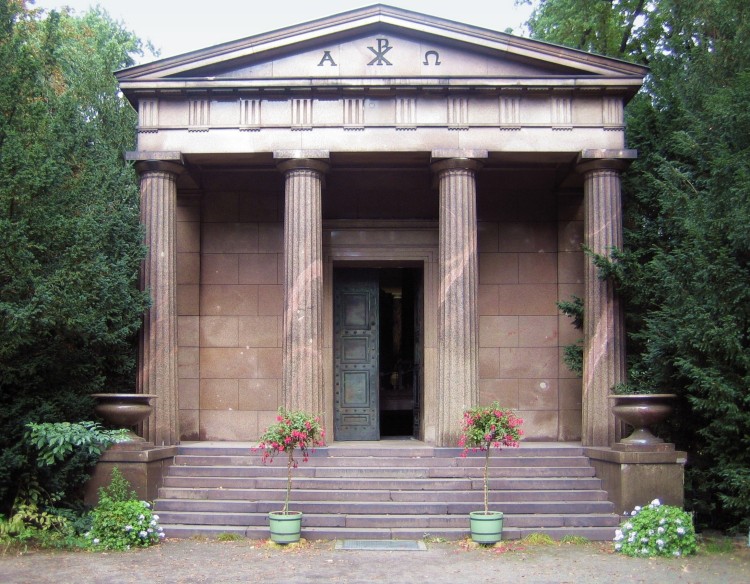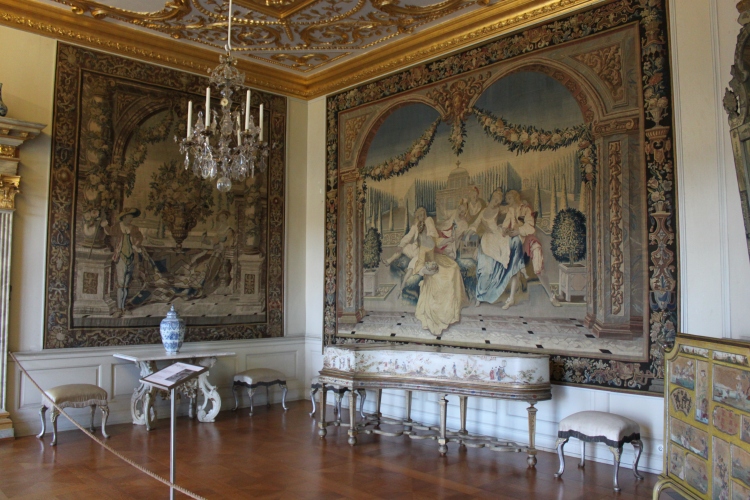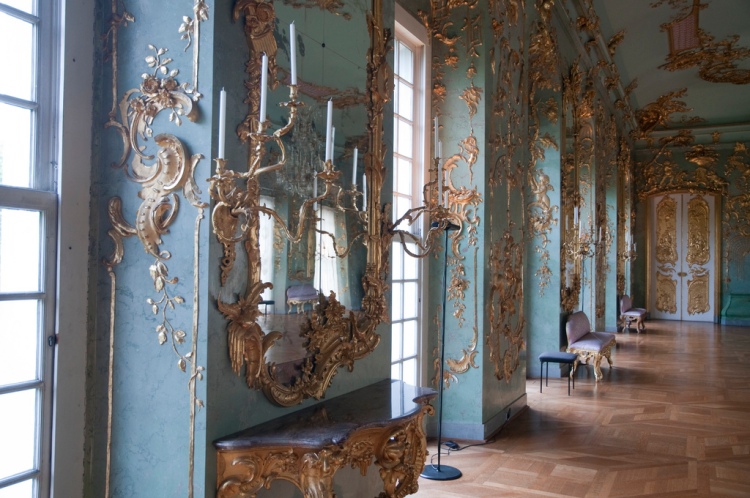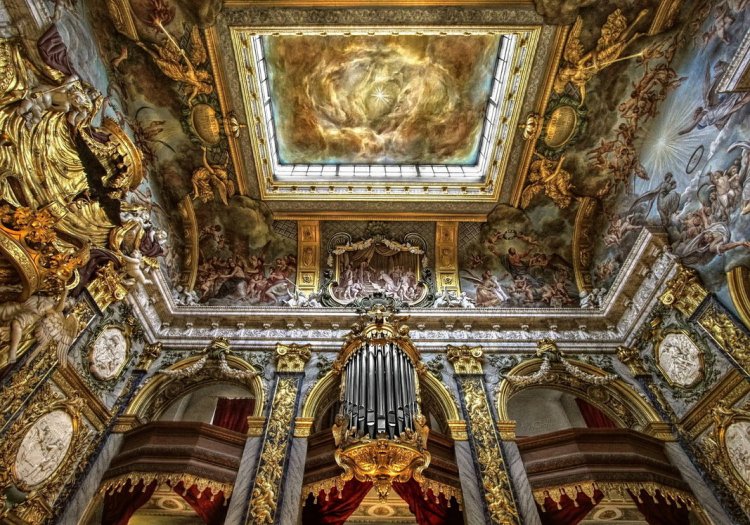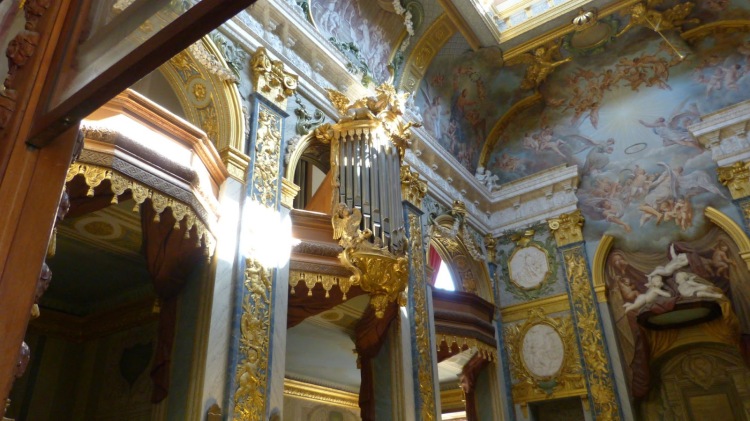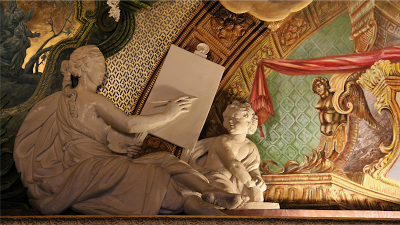The original, central part was constructed between 1695 and 1699 as the summer residence for Sophie Charlotte, wife of the Elector of Brandenburg, Frederick III.The interior features decoration in baroque and rococo styles and a large formal garden surrounded by woodland was added behind the palace.The original palace was commissioned by Sophie Charlotte, in what was then the village of Lietzow. Originally named Lietzenburg, the palace was designed by Johann Arnold Nering in baroque style. It consisted of one wing and was built in 2 1⁄2 storeys with a central cupola. The façade was decorated with Corinthian pilasters. On the top was a cornice on which were statues. At the rear in the centre of the palace were two oval halls, the upper one being a ceremonial hall and the lower giving access to the gardens. Nering died during the construction of the palace and the work was completed by Martin Grünberg and Andreas Schlüter. The inauguration of the palace was celebrated on 11 July 1699, Frederick’s 42nd birthday.
Sophie Charlotte died in 1705 and Friedrich named the palace and its estate Charlottenburg in her memory. Inside the palace, was a room described as “the eighth wonder of the world”, the Amber Room (Bernsteinzimmer), a room with its walls surfaced in decorative amber. It was designed by Andreas Schlüter and its construction by the Danish amber craftsman Gottfried Wolfram started in 1701. Friedrich Wilhelm I gave the Amber Room to Tsar Peter the Great as a present in 1716. The “Porcelain Chamber” was completed in 1706. The greater availability of Chinese and Japanese porcelain from the mid-1600s onward increased interest in this material. Nobles throughout Europe collected porcelain and created “China cabinets”—rooms completely decorated with ceramics displayed on brackets, mantelpieces, shelves, and sometimes even on the floor.
In the beautiful park there a number of buildings such as the
mausoleum, a Doric temple built in 1810 as the burial place for members
of the royal family. It contains the sarcophagus of Friedrich Wilhelm II
among others.
Another building in the garden is the Belvedere, commissioned by Friedrich Wilhelm II and built between 1788 and 1790 as a teahouse. Near the palace is the Schinkel pavilion, built by the renowned German architect Karl Friedrich Schinkel for king Friedrich Wilhelm III. In front of the pavilion are two columns, topped with statues symbolizing victory.
The ‘Orangery’ was built on the west side of the palace and the central area was extended with a large domed tower and a larger vestibule. On top of the dome is a wind vane in the form of a gilded statue representing Fortune designed by Andreas Heidt. The Orangery was originally used to overwinter rare plants. During the summer months, when over 500 orange, citrus and sour orange trees decorated the baroque garden, it was regularly the gorgeous scene of courtly festivities.
When Friedrich I died in 1713, he was succeeded by his son, Friedrich Wilhelm I whose building plans were less ambitious, although he did ensure that the building was properly maintained. Building was resumed after his son Friedrich II (Frederick the Great) came to the throne in 1740.
The palace was hit in 1943 during an allied air raid causing a fire which completely destroyed the building. In 1951, the war-damaged Stadtschloss in East Berlin was demolished and, as the damage to Charlottenburg was at least as serious, it was feared that it would also be demolished. However, following the efforts of Margarete Kühn, the Director of the State Palaces and Gardens, it was rebuilt to its former condition with gigantic modern ceiling paintings by Hann Trier. The Schlosskapelle (palace chapel), has also been completely reconstructed.
At the entrance of the palace stands a large equestrian statue of the Great Elector. It was designed in 1698 by Andreas Schlüter and commissioned by king Friedrich I, the elector’s son. At the base of the statue are four chained warriors, symbolizing the four temperaments (which stem from the antiquity where they were used to describe personalities).
The statue was originally located in front of the Stadtschloss at the Museum Island, but during the Second World War the statue was submerged to the bottom of the Tegeler See, a large lake in Berlin. The statue was recovered in 1952 and after a restoration it was moved to the Charlottenburg Palace.
The Hoher Orden vom Schwarzen Adler (Order of the Black Eagle) can be seen on the gates to the palace.
It was the highest order of chivalry in the Kingdom of Prussia. The order was founded on 17 January 1701 by Elector Friedrich III of Brandenburg.
Membership in the Order of the Black Eagle was limited to a small number of knights, and was divided into two classes: members of reigning houses (further divided into members of the House of Hohenzollern and members of other houses, both German and foreign) and capitular knights.
Parts of the interior of the palace are open to visitors, including the Old Palace (Alte Schloss) and the New Wing (Neuer Flügel). The Old Palace contains many rooms with baroque decoration, and includes a room called the Porcelain Cabinet, which holds thousands of porcelain objects. On special display are the crown jewels and the royal silver and fine porcelain tableware. The New Wing includes the opulent rococo State Apartments of Frederick the Great and the more modest Winter Chambers of Friedrich Wilhelm II. The formal and informal gardens are freely open to the public. For an admission charge, the Mausoleum, the Belvedere and the Neue Pavilion are open to visitors. The Mausoleum contains the graves of, and memorials to, members of the Hohenzollern family. The memorial to Queen Luise includes her reclining effigy, which is made from Carrara marble and was designed by Christian Daniel Rauch. Also open to the public are the Belvedere, which contains a collection of Berlin porcelain, and the Neue Pavilion, which houses a collection of arts and crafts of the period when Schinkel was active. The former Palace Theatre is now the Museum für Vor- und Frühgeschichte, which is a museum of prehistoric archaeology.
Another building in the garden is the Belvedere, commissioned by Friedrich Wilhelm II and built between 1788 and 1790 as a teahouse. Near the palace is the Schinkel pavilion, built by the renowned German architect Karl Friedrich Schinkel for king Friedrich Wilhelm III. In front of the pavilion are two columns, topped with statues symbolizing victory.
The ‘Orangery’ was built on the west side of the palace and the central area was extended with a large domed tower and a larger vestibule. On top of the dome is a wind vane in the form of a gilded statue representing Fortune designed by Andreas Heidt. The Orangery was originally used to overwinter rare plants. During the summer months, when over 500 orange, citrus and sour orange trees decorated the baroque garden, it was regularly the gorgeous scene of courtly festivities.
When Friedrich I died in 1713, he was succeeded by his son, Friedrich Wilhelm I whose building plans were less ambitious, although he did ensure that the building was properly maintained. Building was resumed after his son Friedrich II (Frederick the Great) came to the throne in 1740.
The palace was hit in 1943 during an allied air raid causing a fire which completely destroyed the building. In 1951, the war-damaged Stadtschloss in East Berlin was demolished and, as the damage to Charlottenburg was at least as serious, it was feared that it would also be demolished. However, following the efforts of Margarete Kühn, the Director of the State Palaces and Gardens, it was rebuilt to its former condition with gigantic modern ceiling paintings by Hann Trier. The Schlosskapelle (palace chapel), has also been completely reconstructed.
At the entrance of the palace stands a large equestrian statue of the Great Elector. It was designed in 1698 by Andreas Schlüter and commissioned by king Friedrich I, the elector’s son. At the base of the statue are four chained warriors, symbolizing the four temperaments (which stem from the antiquity where they were used to describe personalities).
The statue was originally located in front of the Stadtschloss at the Museum Island, but during the Second World War the statue was submerged to the bottom of the Tegeler See, a large lake in Berlin. The statue was recovered in 1952 and after a restoration it was moved to the Charlottenburg Palace.
The Hoher Orden vom Schwarzen Adler (Order of the Black Eagle) can be seen on the gates to the palace.
It was the highest order of chivalry in the Kingdom of Prussia. The order was founded on 17 January 1701 by Elector Friedrich III of Brandenburg.
Membership in the Order of the Black Eagle was limited to a small number of knights, and was divided into two classes: members of reigning houses (further divided into members of the House of Hohenzollern and members of other houses, both German and foreign) and capitular knights.
Parts of the interior of the palace are open to visitors, including the Old Palace (Alte Schloss) and the New Wing (Neuer Flügel). The Old Palace contains many rooms with baroque decoration, and includes a room called the Porcelain Cabinet, which holds thousands of porcelain objects. On special display are the crown jewels and the royal silver and fine porcelain tableware. The New Wing includes the opulent rococo State Apartments of Frederick the Great and the more modest Winter Chambers of Friedrich Wilhelm II. The formal and informal gardens are freely open to the public. For an admission charge, the Mausoleum, the Belvedere and the Neue Pavilion are open to visitors. The Mausoleum contains the graves of, and memorials to, members of the Hohenzollern family. The memorial to Queen Luise includes her reclining effigy, which is made from Carrara marble and was designed by Christian Daniel Rauch. Also open to the public are the Belvedere, which contains a collection of Berlin porcelain, and the Neue Pavilion, which houses a collection of arts and crafts of the period when Schinkel was active. The former Palace Theatre is now the Museum für Vor- und Frühgeschichte, which is a museum of prehistoric archaeology.


